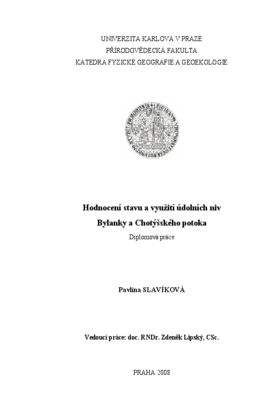Hodnocení stavu a využití údolních niv Bylanky a Chotýšského potoka
Assessment of ecomorphological state and land use of Bylanka and Chotýšský brook flood plains
diplomová práce (OBHÁJENO)

Zobrazit/
Trvalý odkaz
http://hdl.handle.net/20.500.11956/2360Identifikátory
SIS: 33829
Kolekce
- Kvalifikační práce [20326]
Autor
Vedoucí práce
Oponent práce
Matoušková, Milada
Fakulta / součást
Přírodovědecká fakulta
Obor
Fyzická geografie a geoekologie
Katedra / ústav / klinika
Katedra fyzické geografie a geoekologie
Datum obhajoby
28. 5. 2008
Nakladatel
Univerzita Karlova, Přírodovědecká fakultaJazyk
Čeština
Známka
Velmi dobře
This diploma thesis is dealing with geoecological assessment of water courses in the Bylanka catchment. The model area is situated in the Central Bohemia in the district Kolín. The catchment has a character of flat hilly country with the highest altitudes over 400 m. Most of the area is used as fields, forests cover only 9 % of the territory. Bylanka (8,4 km) and its longest affluent Chotýšský brook (10,6 km) were chosen as model water courses. The geoecological assessment is composed of three different methods. Ecomorfological assessment (Matoušková, 2003) was used for water courses evaluation. This method divides the stream and its surroundings into 4 ecomorfological zones: stream channel, vegetation belt, flood plain and water basin. The final ecomorfological state is better in the case of Bylanka because this stream is less anthropogenic transformed due to deeper erosive incision in the Permian-Carboniferous formations where human couldn't change the stream flow. Proliferation of bank and riparian vegetation is the second method of water courses and its surroundings evaluation. White willow (Salix alba), black poplar (Populus nigra), aspen tree (Populus tremula) and common alder (Alnus glutinosa) are the most frequently occurring wood species. Land use changes in the flood plain of Bylanka and...
